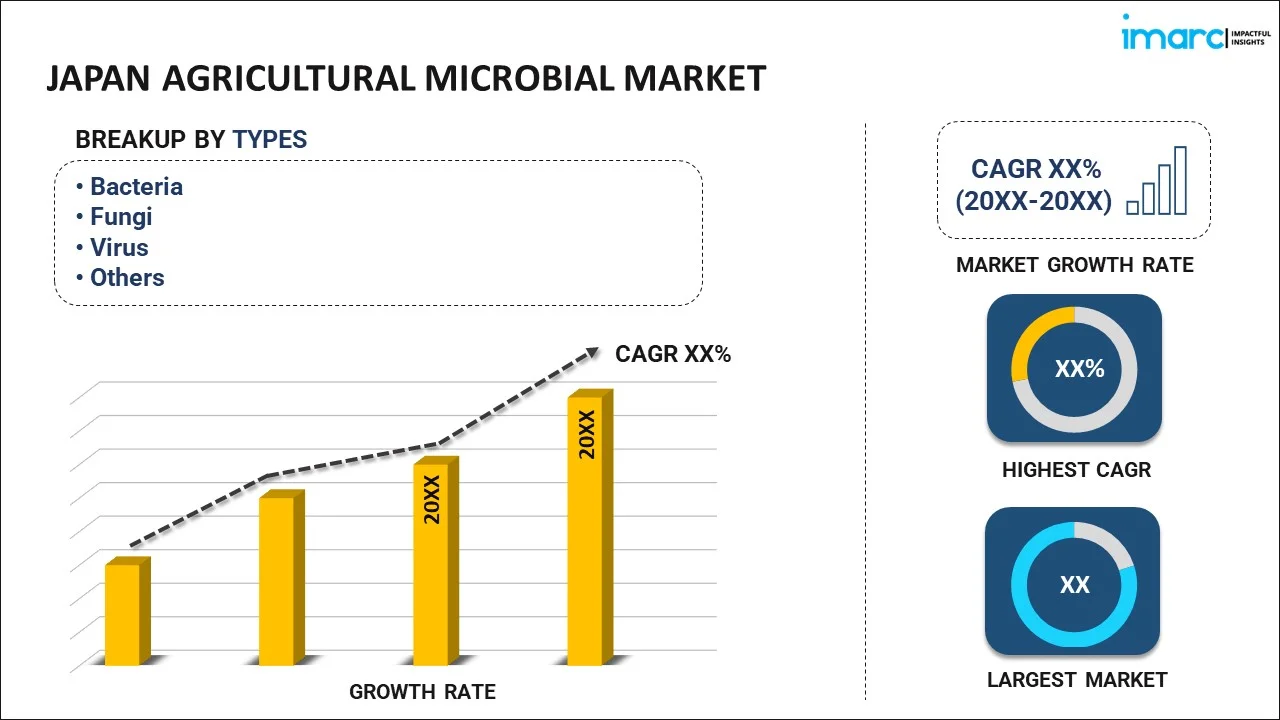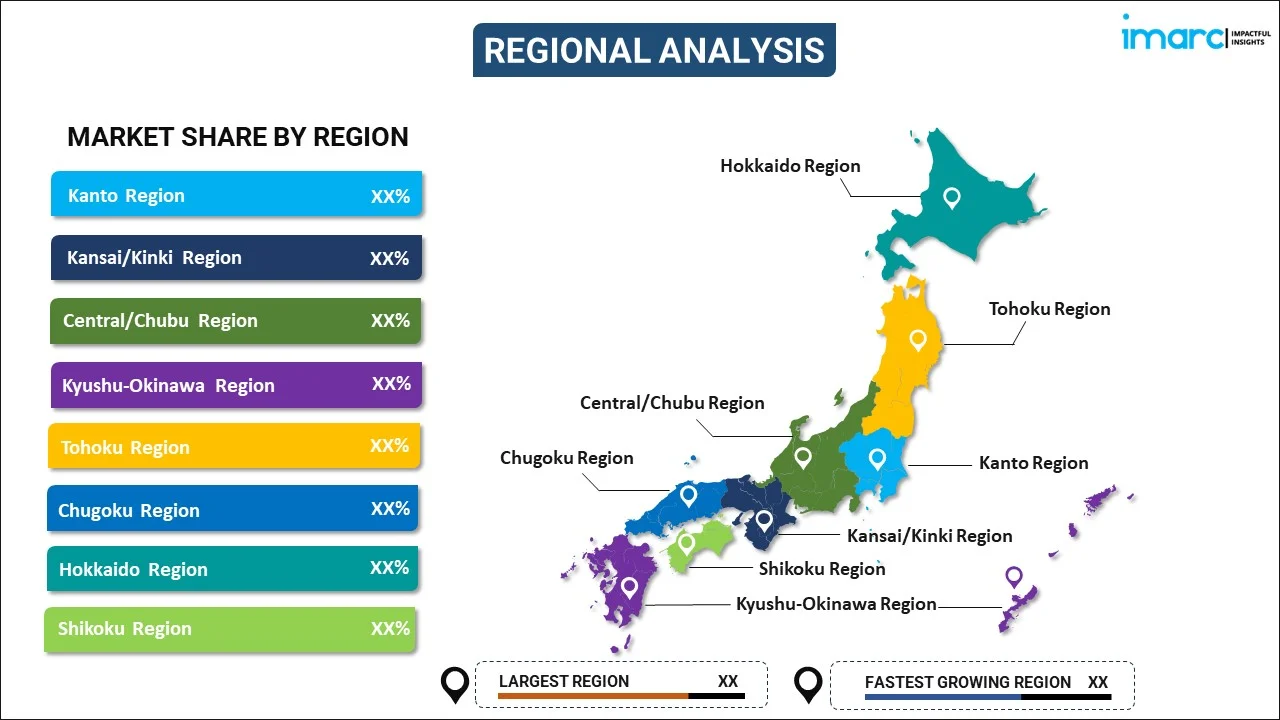
Japan Agricultural Microbial Market Report by Type (Bacteria, Fungi, Virus, and Others), Formulation (Dry, Liquid), Application Method (Soil Amendment, Crop Protection), Function (Foliar Spray, Soil Treatment, Seed Treatment, and Others), Crop Type (Cereals, Oilseeds and Pulses, Fruits and Vegetables, and Others), and Region 2025-2033
Market Overview:
Japan agricultural microbial market size reached USD 627.0 Million in 2024. Looking forward, IMARC Group expects the market to reach USD 2,201.0 Million by 2033, exhibiting a growth rate (CAGR) of 13.70% during 2025-2033. The increasing demand for sustainable agricultural practices that offer eco-friendly solutions for pest control, nutrient management, and soil health improvement, is driving the agricultural microbial market.
|
Report Attribute
|
Key Statistics
|
|---|---|
|
Base Year
|
2024 |
|
Forecast Years
|
2025-2033
|
|
Historical Years
|
2019-2024
|
| Market Size in 2024 | USD 627.0 Million |
| Market Forecast in 2033 | USD 2,201.0 Million |
| Market Growth Rate (2025-2033) | 13.70% |
Agricultural microbiology is a branch of science that focuses on the study of microorganisms in relation to agriculture. It encompasses the investigation of various microorganisms, including bacteria, fungi, viruses, and protozoa, and their interactions with plants, animals, and the overall ecosystem in agricultural settings. Microbes play crucial roles in agriculture. Beneficial microorganisms can enhance soil fertility by fixing nitrogen, decomposing organic matter, and promoting nutrient cycling. They can also protect plants from diseases and pests, reducing the need for chemical pesticides. Additionally, microbial biotechnology is employed in agriculture to produce biofertilizers, biopesticides, and genetically modified crops. Conversely, harmful microbes can cause plant and animal diseases, leading to significant economic losses. Therefore, agricultural microbiologists also study ways to control and mitigate these negative impacts through methods like disease management strategies and the development of disease-resistant crop varieties. In summary, agricultural microbiology explores the diverse roles of microorganisms in agriculture, with the goal of improving crop yields, soil health, and sustainability while minimizing the negative impacts of harmful microbes.
Japan Agricultural Microbial Market Trends:
The agricultural microbial market in Japan is witnessing robust growth, primarily due to several key drivers that are shaping the industry landscape. Firstly, the increasing regional population and the subsequent rising demand for food have put immense pressure on traditional agricultural practices. Consequently, farmers are actively seeking sustainable and environmentally friendly solutions to boost crop yields. This has paved the way for the adoption of agricultural microbial products. Additionally, the growing awareness of the adverse effects of chemical pesticides and fertilizers on the environment and human health has prompted a shift towards biological alternatives. As a result, microbial-based agricultural products, such as biopesticides and biofertilizers, are gaining traction. Moreover, stringent regulations regarding the use of chemical inputs in agriculture are encouraging farmers to explore microbial solutions that are often considered safer and more eco-friendly. Furthermore, advancements in biotechnology and genetic engineering, which have enabled the development of more effective and customized microbial products, enhancing their appeal to farmers, are expected to drive the agricultural microbial market in Japan during the forecast period.
Japan Agricultural Microbial Market Segmentation:
IMARC Group provides an analysis of the key trends in each segment of the market, along with forecasts at the country level for 2025-2033. Our report has categorized the market based on type, formulation, application method, function, and crop type.
Type Insights:

- Bacteria
- Fungi
- Virus
- Others
The report has provided a detailed breakup and analysis of the market based on the type. This includes bacteria, fungi, virus, and others.
Formulation Insights:
- Dry
- Liquid
A detailed breakup and analysis of the market based on the formulation have also been provided in the report. This includes dry and liquid.
Application Method Insights:
- Soil Amendment
- Crop Protection
The report has provided a detailed breakup and analysis of the market based on the application method. This includes soil amendment and crop protection.
Function Insights:
- Foliar Spray
- Soil Treatment
- Seed Treatment
- Others
A detailed breakup and analysis of the market based on the function have also been provided in the report. This includes foliar spray, soil treatment, seed treatment, and others.
Crop Type Insights:
- Cereals
- Oilseeds and Pulses
- Fruits and Vegetables
- Others
The report has provided a detailed breakup and analysis of the market based on the crop type. This includes cereals, oilseeds and pulses, fruits and vegetables, and others.
Regional Insights:

- Kanto Region
- Kansai/Kinki Region
- Central/ Chubu Region
- Kyushu-Okinawa Region
- Tohoku Region
- Chugoku Region
- Hokkaido Region
- Shikoku Region
The report has also provided a comprehensive analysis of all the major regional markets, which include Kanto Region, Kansai/Kinki Region, Central/ Chubu Region, Kyushu-Okinawa Region, Tohoku Region, Chugoku Region, Hokkaido Region, and Shikoku Region.
Competitive Landscape:
The market research report has also provided a comprehensive analysis of the competitive landscape. Competitive analysis such as market structure, key player positioning, top winning strategies, competitive dashboard, and company evaluation quadrant has been covered in the report. Also, detailed profiles of all major companies have been provided.
Japan Agricultural Microbial Market Report Coverage:
| Report Features | Details |
|---|---|
| Base Year of the Analysis | 2024 |
| Historical Period | 2019-2024 |
| Forecast Period | 2025-2033 |
| Units | Million USD |
| Scope of the Report | Exploration of Historical Trends and Market Outlook, Industry Catalysts and Challenges, Segment-Wise Historical and Future Market Assessment:
|
| Types Covered | Bacteria, Fungi, Virus, Others |
| Formulations Covered | Dry, Liquid |
| Application Methods Covered | Soil Amendment, Crop Protection |
| Functions Covered | Foliar Spray, Soil Treatment, Seed Treatment, Others |
| Crop Types Covered | Cereals, Oilseeds and Pulses, Fruits and Vegetables, Others |
| Regions Covered | Kanto Region, Kansai/Kinki Region, Central/ Chubu Region, Kyushu-Okinawa Region, Tohoku Region, Chugoku Region, Hokkaido Region, Shikoku Region |
| Customization Scope | 10% Free Customization |
| Post-Sale Analyst Support | 10-12 Weeks |
| Delivery Format | PDF and Excel through Email (We can also provide the editable version of the report in PPT/Word format on special request) |
Key Questions Answered in This Report:
- How has the Japan agricultural microbial market performed so far and how will it perform in the coming years?
- What has been the impact of COVID-19 on the Japan agricultural microbial market?
- What is the breakup of the Japan agricultural microbial market on the basis of type?
- What is the breakup of the Japan agricultural microbial market on the basis of formulation?
- What is the breakup of the Japan agricultural microbial market on the basis of application method?
- What is the breakup of the Japan agricultural microbial market on the basis of function?
- What is the breakup of the Japan agricultural microbial market on the basis of crop type?
- What are the various stages in the value chain of the Japan agricultural microbial market?
- What are the key driving factors and challenges in the Japan agricultural microbial?
- What is the structure of the Japan agricultural microbial market and who are the key players?
- What is the degree of competition in the Japan agricultural microbial market?
Key Benefits for Stakeholders:
- IMARC’s industry report offers a comprehensive quantitative analysis of various market segments, historical and current market trends, market forecasts, and dynamics of the Japan agricultural microbial market from 2019-2033.
- The research report provides the latest information on the market drivers, challenges, and opportunities in the Japan agricultural microbial market.
- Porter's five forces analysis assist stakeholders in assessing the impact of new entrants, competitive rivalry, supplier power, buyer power, and the threat of substitution. It helps stakeholders to analyze the level of competition within the Japan agricultural microbial industry and its attractiveness.
- Competitive landscape allows stakeholders to understand their competitive environment and provides an insight into the current positions of key players in the market.
Need more help?
- Speak to our experienced analysts for insights on the current market scenarios.
- Include additional segments and countries to customize the report as per your requirement.
- Gain an unparalleled competitive advantage in your domain by understanding how to utilize the report and positively impacting your operations and revenue.
- For further assistance, please connect with our analysts.
 Inquire Before Buying
Inquire Before Buying
 Speak to an Analyst
Speak to an Analyst
 Request Brochure
Request Brochure
 Request Customization
Request Customization




.webp)




.webp)












